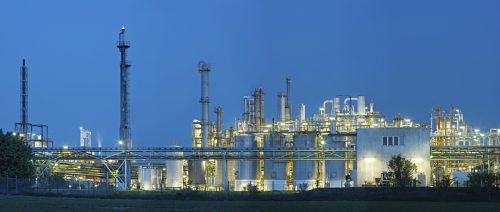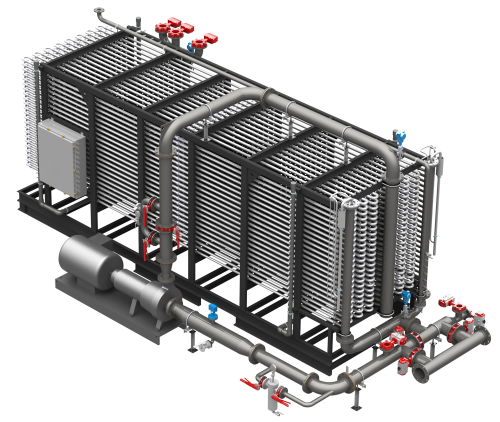

Membranes are being substituted for chemical treatment of wastewaters to reduce chemical, analytical, and labour costs, as well as to produce cleaner and more consistent effluent for discharge or recycle. Typical wastewaters can be treated with ultrafiltration and reverse osmosis membranes and sent back to the facility as clean water.Membrane systems are often designed to use existing equipment and tanks to minimise implementation costs. Membrane bioreactors are ideal solutions to help reduce plant footprints and operating costs.For in-process applications, new uses for membrane systems to update, enhance, or replace conventional processes are constantly emerging.The chemical industry demonstrates many examples of how membrane technology is rapidly replacing conventional methods to concentrate and recover materials from process streams. Many chemical processing operations require the removal of water to achieve greater product recovery, reduce spent material disposal costs, and increase plant efficiency. Membranes are an extremely efficient means to accomplish filtration and separation and offer the additional benefits of reduced energy consumption and operating costs over traditional treatment methods. Chemical companies also rely on membrane filtration systems for front-end water treatment, often with reverse osmosis membranes, to ensure consistent water quality in their processes, as well as to recover and conserve water.
Applications in speciality chemicals
Membrane filtration can be used to concentrate spent materials for disposal or recycling. In chemical mechanical polishing (CMP) applications, for example, the spent silica solution used for polishing and contaminant removal can be concentrated using ultrafiltration and reverse osmosis membranes to reduce the volume and costs for disposal. Increased efficiencies can also be gained by capturing valuable raw materials and other products from wash water for reuse; silica can be recovered and reused, as can paints, dyes, inks, catalysts, surfactants, and precious metals. Decontaminated filtrate is also recovered for reuse in these applications.Membrane filtration is a cost-effective alternative in many operations where evaporation, or dewatering, is involved to concentrate the process stream. In latex, mineral, and other applications, dewatering by membrane systems prior to spray drying significantly decreases drying cost and increases plant efficiency and capacity. Ultrafiltration and reverse osmosis technology can greatly reduce operating costs compared to the traditional method of using an evaporator to recover or remove water, which requires very high energy use.Diafiltration, a wash process, is another key application for membranes in the chemicals industry. Hollow fibre ultrafiltration membranes can be used to displace materials, such as salts, from retained solids. A good example of this can be seen in the manufacture of inks, dyes and pigments. Ink processes can have high salt concentrations; the salts are easily separated from the inks using the correctly sized membrane. Tubular membranes, used for high solid streams, can be used to wash out unwanted dissolved contaminants from pigments manufactured for the textile industry to increase final product quality and relative value.
Applications in industrial biotechnology
Membrane filtration technology is now being adopted in biofuels production and integrated biorefineries to lower overall energy costs, reduce waste, and increase valuable product recovery. Membrane use is rising in biodiesel processes where membranes facilitate water reuse, particularly in areas where water is scarce. Membranes are also being used to achieve optimum yields in continuous and batch fermentation processes.A tremendous amount of work is going into using membrane filtration to extract fermentable material in the production of second-generation cellulosic bioethanol. For example, ultrafiltration is used for clarifying the process stream after turning it into sugars during the saccharification process.Some processes use acid/alkali, and nanofiltration can be used to recover and concentrate some of the useful sugars like hemi-cellulose, which also is used in the fermentation process. Nanofiltration is used for low molecular weight component fractionation and desalting applications, where the process streams may have high concentrations of acids and base chemicals and organic solvents/water mixture.An emerging process for the biofermentation cycle involves converting cellulosic materials to sugars and then fermenting them to organic compounds in the form of acids and alcohols.The fermentation process typically produces a low concentration substrate that requires clarification and concentration to be economically viable. Crossflow filtration using spiral wound and hollow fibre membranes is being effectively employed to provide high product recovery and consistent filtrate quality for downstream processing steps.Chemical processes involving fermentation are also utilising membranes. Optimum yields are difficult to obtain from fermentation-derived chemicals such as amino acids, organic acids, vitamins, enzymes, and polymers. Microfiltration and ultrafiltration membranes can remove the bulk of the microbial cell mass and proteins to improve the downstream recovery of the valuable product. Nanofiltration can contribute to process efficiency by removing low molecular weight components like colour bodies or monovalent salts from the process stream. Reverse osmosis can enable recovery and reuse of water or recover product from certain dilute product streams to improve process yield.One interesting development application driving the interest in membrane technology is its ability to operate at higher temperatures. Operators seek ways to run continuous fermentation, rather than a batch process. The next few years will see a great increase in demonstration plants working on continuous fermentation, and membranes are poised to play a significant role in this important advancement.
An overview of membrane technology
Membrane filtration systems excel in cost- and energy efficiency because they are precisely tailored to the specific requirements of the finished product. There are four primary membrane technologies spanning a range of pore sizes that suit numerous applications, from removing salt to filtering large particulates in viscous fluids. Reverse osmosis offers the finest degree of separation, followed by nanofiltration, ultrafiltration and microfiltration.Microfiltration has significant applications in simple dead-end filtration for water, sterile fruit juices and wine, and aseptic pharmaceuticals. A large portion of the microfiltration market has been captured by crossflow. The most common of these is the clarification of whole cell broths and purification processes in which macromolecules must be separated from other large molecules, proteins, or cell debris. As with ultrafiltration, MF systems operate at relatively low pressures and come in a variety of configurations.Ultrafiltration is a pressure-driven process that removes emulsified oils, metal hydroxides, colloids, emulsions, dispersed material, suspended solids, and other large molecular weight materials from water and other solutions. Ultrafiltration membranes are characterised by their molecular weight cut-off. Ultrafiltration excels at the clarification of solutions containing suspended solids, bacteria, and high concentrations of macromolecules.Nanofiltration functions similarly to reverse osmosis, but is generally targeted to remove only divalent and larger ions. Monovalent ions such as sodium and chloride will pass through a nanofiltration membrane; therefore many of its uses involve de-salting of the process stream. In water treatment, nanofiltration membranes are used for hardness removal (in place of water softeners), pesticide elimination, and colour reduction. It can also be used to reclaim spent NaOH solutions, in which case the permeate stream is purified NaOH, allowing reuse many times over.Reverse osmosis membranes feature the smallest pores and involve, appropriately enough, the reversal of osmotic pressure in order to drive water away from dissolved molecules.Strictly speaking, reverse osmosis is not a size exclusion process based on pore size; it depends on ionic diffusion to affect separation. One of its common applications is seawater desalination. Reverse osmosis is also used in wastewater volume reduction and other industrial processes, with the goal of producing a pure filtrate (typically water) or retaining the components.Membranes come in four basic configurations—tubular, spiral, hollow fibre and flat sheet—to address the range of physical characteristics found in process fluids. Membrane technologies and configurations can also be used in combination to provide the most efficient, compact way to address specific process streams.
Membrane solutions for the chemical industry
Koch Membrane Systems has a number of membrane separation solutions for use in the chemical industry. ABCOR® ULTRA-COR®, INDUCOR™, and the FEG™ PLUS family of tubular membranes, and the ROMICON® family of hollow fibre membrane products are ideal for in-process membrane separation applications, including the treatment of streams for concentration and/or recovery from: printing and pigments industry; surfactant production; electronic production; industrial laundering; latex production;pulp and paper solids reduction and water recycle; textile processes; chemical processing industry; and the minerals processing industries.ABCOR tubular products can be custom built into a KMS KONSOLIDATOR™ system, which is designed particularly for high final concentration of solids or fibrous material.The SelRO® acid/base stable membranes are characterised by good chemical and thermal stability. Typical applications for these membranes include: decolourisation/clarification/demineralisation of spent acid and caustic solutions for recycle; concentration and demineralisation of dyes in acids; concentration/desalination/softening of in-process and waste streams; and COD/BOD reduction waste streams such as pulp and paper waste effluents.






